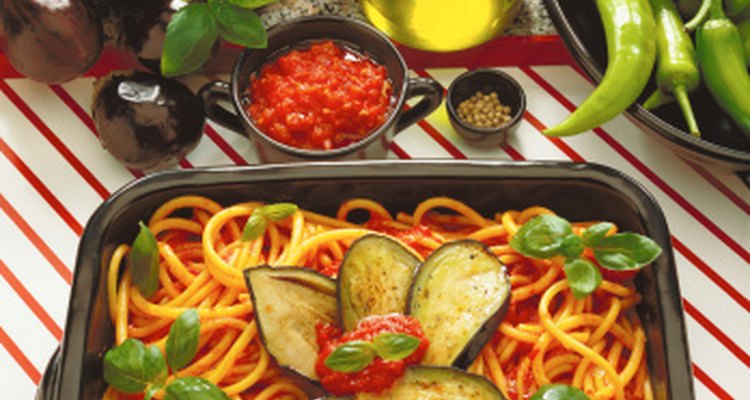
While adding vegetables to pasta dishes contributes extra vitamins and fiber, juggling pans, burners and cooking times can be daunting. Planning ahead is crucial. Check the boiling time recommended on the spaghetti and frozen vegetable packaging, if any. For fresh vegetables, consult a cookbook if you are unsure of standard cooking times. Dense or thick-skinned vegetables such as winter squash, beets or artichokes usually take longer to cook than pasta, while peas and spinach are ready in as little as two minutes.
One-Pot Method
Wash, peel and chop the vegetables, as needed.
Fill a large stock pot about three-quarters full of water, and set it on the stove with the burner set to high.
Add the first ingredient to the pot, which may be pasta or a type of vegetable, depending on the ingredients of your dish.
Set a timer for the highest number of minutes after you add the first ingredient to guide you for the other ingredients. Winter squash cubes take about 15 minutes, for example, while fresh peas take two to three minutes. Pasta may fall in between, at around 10 minutes.
Add the rest of the vegetables and the pasta in order of their cooking times. For the example in Step 4, put the winter squash in the pot and set the timer for 15 minutes. At the 10 minute mark, add pasta, and at the three- minute mark, add peas.
Remove the pot from the heat when the timer sounds, and drain in a colander.
Toss with olive oil and preferred seasonings, or microwave store-bought pasta sauce on a moderate heat, and spoon it over the pasta and veggies.
Pasta with Sautéed Vegetables.
Wash, peel and chop vegetables, as needed. If you are using tomatoes or bell peppers, scoop out the seeds.
Fill a large stock pot about three-quarters full of water, and put it on a burner set to high.
Add about 5 tbsp. olive oil to your saute pan, and set the burner to medium.
Sauté the vegetables, adding longer-cooking vegetables like bell peppers first and adding vegetables such as asparagus spears, summer squash, onions and mushrooms five minutes later, with tomatoes and pea pods about five minutes after that.
Put spaghetti in the pot of boiling water.
Stir the vegetables frequently while the spaghetti is boiling, for about 10 minutes.
Remove the stock pot from the heat, and drain spaghetti in a colander.
Add about one-third of the cooked spaghetti to the sauté pan, and incorporate it into the vegetables. Continue with the rest of the spaghetti.
Spaghetti Primavera
Steam or sauté about 6 cups of mixed vegetables and set aside..
Heat store-bought pasta sauce, or make your own. Mayo Clinic's pasta primavera sauce combines 1 tbsp butter, 1 cup nonfat evaporated milk and 3/4 cup Parmesan cheese, which is stirred at a medium-low heat until it thickens. Keep your spaghetti sauce warm until the pasta cooks.
Fill a large stock pot about three-quarters full of water and set it on the stove with the burner set to high.
Return to the sauté pan, and cook the onions and garlic in the olive oil, then add the previously cooked vegetables.
Drain the spaghetti in a colander, and pour the drained pasta into a large serving bowl.
Remove the sauté pan from the burner, and spoon the vegetables over the pasta.
Ladle the primavera sauce over the spaghetti and vegetables, and serve.
Related Articles

How to Cook Penne Rigate Noodles in the ...

How to Cook Spaghetti to Use the Next ...

How to Improve Jar Spaghetti Sauce With ...

How to Cook Luglug Cornstarch Noodles

How to Cook Kale in a Pan With Butter ...

How to Cook Lasagna Noodles so They ...

How to Make Mac & Cheese Using Alfredo ...

How to Cook Zucchini Like a Japanese ...

How to Reheat Lasagna

How to Defrost a Casserole Quickly

Can You Boil Water & Cook Spaghetti in ...

How to Cook Pasta in the Microwave or ...

How to Shrink a Cotton Polo

How to Preserve Rutabagas

How to Dry Broccoli

How to Cook Hu Tieu Noodles

How to Replace Flour With Oat Flour
How to Cook Large Amounts of Noodles ...

How to Make Crock-Pot Spaghetti

How to Make a Boneless Chicken Casserole
References
Resources
Tips
- After adding the pasta, wait until it comes to a second boil, then turn down the heat. This method not only ensures even cooking of the pasta, it also cooks vegetables more gently when using the one-pot method.
- Use whole-wheat spaghetti to make your meal even healthier.
- If you use commercial pasta sauce, heat it in the microwave at a moderate temperature to save room on the stove for stockpots and sauté pans.
- A one-pot method is simplest, but preparing the vegetables separately enhances the nutrient value because you don't wash the vitamins down the sink when you drain the pasta and vegetables.
Warnings
- Do not over-boil vegetables, because the vigorous boiling needed for the pasta to cook may drain the vegetables of flavor or nutrition. Drain the vegetables well before serving them.
- Double-check the recommended cooking time of your spaghetti. Freshly made pasta takes less time to cook than dry, boxed spaghetti.
Writer Bio
Ellen Douglas has written on food, gardening, education and the arts since 1992. Douglas has worked as a staff reporter for the Lakeville Journal newspaper group. Previously, she served as a communication specialist in the nonprofit field. She received her Bachelor of Arts from the University of Connecticut.
Photo Credits
Stockbyte/Stockbyte/Getty Images